
Traffic situations can change rapidly. Because of this, it's essential to know where you are, what's around you and what you can safely do next. You can achieve all of these things by using a 'hazard routine'.
A hazard routine is a system of actions you use each time you approach a hazard.
A hazard is anything that causes you to change your speed or direction, for example, junctions, parked cars, animals on the road, potholes, cyclists – anything at all!
Using a routine approach will help ensure that any action you take to deal with the hazard is safe.
Driving is a constant process of gathering information and taking action. You start by getting information about what's happening on the road and then you consider what you need to do to 'fit in'. (And take whatever action is necessary).
As with other things in life, it is a good idea to have a system to do these things efficiently.
 For example, a system for grocery shopping might be:
For example, a system for grocery shopping might be:
Check the food cupboard/fridge to find out what I need to buy
Consider other family members and what they might want
Make a shopping list
Decide where to buy the things on the list
Make the shopping trip
You might not realise it consciously, but your whole life is made up of routines.
The 'hazard routine' is simply a method to help ensure you stay safe when driving.
There are various versions of the hazard routine. The police version is called 'the system of car control' and some advanced motoring associations have also developed specific routines. The routine we discuss here is an expanded version of the Mirrors, Signal, Manoeuvre routine which breaks down into:
Mirrors - Signal - Position, Speed & Gear - Look, Assess, Decide, Act
This might seem like a lot to remember, but it's an easy routine to follow when you are on the road and will very quickly become common sense.
Driving test examiners do not specifically mark that you are using a routine approach to your driving. However, they consider each part of the routine and whether you are fully aware of what is happening around you, correctly communicating with other drivers and controlling the car properly.
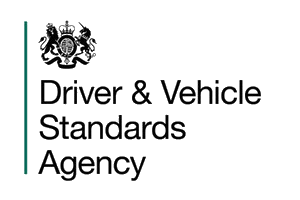
Things that examiners consider:
Mirrors: Do you use them when needed and act on what you see?
Signals: Are your signals well-timed and given correctly?
Road position: Do you maintain a good road position and use the correct lanes?
Speed: Is your speed appropriate for the situation?
(Manual car) Do you use the best gear at all times?
(Automatic) Do you use the appropriate auto gear setting?
How well do you observe the road ahead and assess situations?
Do you take safe and appropriate action to deal with the hazard?
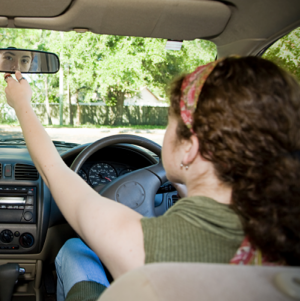
You will probably remember from earlier info in DriverActive that you should check your mirrors often, so you know what's behind.
Specifically, you need to check your mirrors before you:
Give signals
Change your direction
Change your speed
Stop
Overtake
Open your door
As soon as you become aware of a hazard, check your mirrors to see what is happening behind you.
Just looking at the mirrors is not enough; you must ask yourself, "Is it safe to carry out my intended manoeuvre?"
The routine starts with 'MIRRORS' - you will get the best information by using at least two of your mirrors when approaching a hazard. It does no harm to check all three.
Use quick glances when you look at your mirrors. Two or three glances will often give more information than a long 'stare' - also, if you look at the mirrors for too long, you will be distracted from the road ahead and could easily steer off course.
Although 'mirrors' is only mentioned once in the routine, you will need to use your mirrors more than once for most situations. For example, if you check your mirror and then decide to give a signal, you will need to recheck the mirror to find out how the driver behind is responding to your signal.
Another valuable thing to remember is that everything you do when driving starts and finishes with a mirror check.*
The need for the first mirror checks explained above will be pretty obvious. However, not everyone remembers to check their mirrors after a manoeuvre, which is equally important. For example, if you have turned left or right, you will need a final check when you are on the 'new road' to make sure that it's safe to increase your speed after turning (there could be someone trying to overtake you).
*The only exception is stopping in an emergency where mirrors are still very important but are not the first priority.
Above, we said that just looking 'at' the mirrors is not enough - you have to consider what you see and how it might affect you. For example:
Is the vehicle behind too close?
If the answer is 'yes', it might be necessary to give an early warning with your brake lights to give the driver plenty of time to react.
Knowing that the vehicle behind is too close will enable you to plan to leave more space ahead - this also creates more time to react.
Is the driver behind thinking of overtaking?
This information is essential if your manoeuvre involves a right turn or position change to the right.
If you suspect that the vehicle behind is going to overtake, you might give an early signal or allow it to pass before starting your manoeuvre. In extreme situations, you might even have to abort the manoeuvre.
Questions you might ask yourself:
"Will the vehicle behind overtake?"
"Is the other driver responding to my signal?"
"What's happening two or three cars back?"
"Will the cyclist try to overtake on the left?"
Remember: Just looking at the mirrors is not enough; you must always ask yourself, "Is it safe to carry out my intended manoeuvre?"
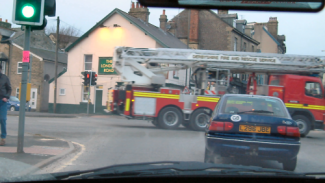
You normally expect to keep going at a green light - and so does the driver behind you.
But what if you hear an emergency siren?
The siren is a hazard - check the mirrors.
If the emergency vehicle isn't behind, there is a good chance it will appear from one of the other roads at the traffic lights, meaning that you might have to stop even though the lights are green.
At this point, the drivers behind might not expect you to stop, so mirrors are essential to make it safe.
If the driver behind has not seen you stopping, you can pump your brakes to flash the brake lights on and off or sound your horn to grab their attention.
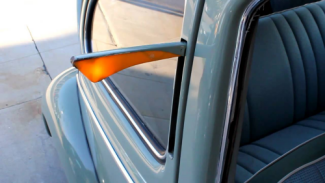
After checking your mirrors to make sure that your intended manoeuvre is safe, ask yourself if there are any other road users who need to know what you intend to do. If the answer is yes, give the appropriate signal.
There will be times when you are unsure whether to give a signal or not.
Normally, if you have checked your mirrors and considered the other road users around you and you are still unsure, a signal will do no harm.
The following guidelines will help you to make your decision:
When moving off signal to warn any other road user who might be affected by your action.
This means pedestrians in the immediate vicinity of your car, cyclists who might be thinking of passing you or drivers in front and behind. If there is no one to benefit, there's no need to signal.
Passing parked cars you will normally only signal if you consider that the vehicle behind might be thinking of passing you or if an approaching vehicle is moving into your road space in a narrower road.
In the 'olden days' signals were given with a 'traficator signal' like the one in the picture. These popped out to the left or the right when the driver flicked a switch.
Traficator signals disappeared from use in the mid 1960's. But the need to consider signals as part of your hazard routine remains.
The correct timing of signals is essential to help other road users.
Signalling too early or too late for junctions and other situations can be confusing and possibly misleading. Give plenty of warning when you intend to turn or change position - and then check your mirrors to make sure that drivers behind are responding appropriately.
After making sure it's safe (with extra mirror checks if necessary), you need to consider your position on the road. This could mean staying where you are, moving position in your lane or changing lanes.
At this point, it's worth remembering why you are using a routine.
Mirrors first: If you were to signal before using your mirrors, you could confuse others by giving misleading information.
For example, if someone was starting to overtake you and you signalled to turn right without realising that they were there, you could cause them to panic.

Signal before position: Signal before position. If you change position before giving a signal, you risk a collision with someone who does not realise you are moving out (or in) - or road rage from someone who feels that you have 'cut them up'!
It is essential to know what others are doing before starting to manoeuvre (check your mirrors), but it is equally important that they understand what you are about to do (give a signal).
Road position reinforces signals. Often, when drivers position incorrectly for a manoeuvre, other drivers will notice the position more than the signal (thinking that the signal has been given by mistake).
Speed & gear: So far, you've checked your mirrors, considered a signal (and given one if necessary) and taken up a good road position. Now you need to make final adjustments to your speed and gear.
Notice that we say 'final adjustment' to speed and gear. This is because you might have already started to adjust your speed by releasing the gas pedal.
Depending on your manoeuvre, you could be speeding up or slowing down – however, in the vast majority of day-to-day driving, it's reasonable to assume that most of the time, you will be reducing speed as part of this routine.
The timing of your speed reduction is essential, especially if you are changing lanes to turn at a junction. If you slow down before changing lanes, you risk holding people up unnecessarily. Another example you will learn about later is slowing down to leave a motorway - in that situation, you need to leave the main carriageway before reducing speed.
Occasionally you will come across drivers who start to reduce their speed for a junction before they put on a signal. This can be very confusing for the driver behind when they see the brake lights but don't know why the car ahead is slowing down.
In a manual car it's important to slow down before changing gear. By reducing your speed in good time you will get a smoother gear change.
Whether you are in a manual, automatic or electric car, slowing down in good time will create time for observation. When you are learning, it is initially better to be a bit too slow than too fast. You can increase your speed as you gain more skill and confidence.
Keep a constant lookout for other road users throughout the routine. Remember that this will mean using your mirrors at least twice to get all the necessary information for good driving decisions. This is especially important before moving off, changing lanes or moving from one road to another.

Even though you will be doing everything necessary to warn and inform others of your intended actions, there might be times when you make mistakes - or when other road users are not paying as much attention as they should be.
The DVSA suggests that you take great care when finishing your manoeuvre. As a final check, they suggest the following sequence (L.A.D.A.):
Look: Ask yourself, "Who will be affected by my actions?" You are not just looking for cars, trucks and buses. You are also looking for pedestrians (especially the old and the young), cyclists and motorcyclists.
Assess: What are the other road users doing, and how will your actions affect them?
Decide: Base you decision to wait or go on the information you have gathered. You must not cause anyone else to speed up, slow down, swerve out of the way or take any other evasive action.
Act: Be positive - when you have made your decision, get on with it! Hesitant actions confuse others on the road and can be as dangerous as speeding!
The example below shows how you would use the routine when making a right turn from a main road into a side road.
Step 1: Mirrors
As soon as you know that there is a hazard ahead, in this case, a right turn, you must check both your interior and right* door mirrors to see what is happening behind - ask yourself the question: "Is it safe to carry out my intended turn?"
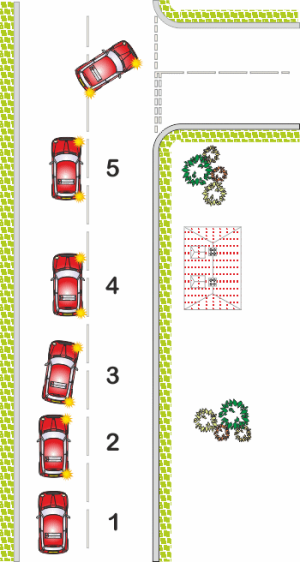
* In some situations, a left door mirror check can be equally useful.
Step 2: Signal
When you are sure it's safe to proceed, ask yourself if any other road users need to know what you intend to do. If the answer is yes, give the appropriate signal.
After giving a signal, you will need a second mirror check to see how the driver behind is reacting and to ensure it's safe to move into position.
Step 3: Position
When rechecking your mirrors to check that it's safe to move into position (in this case, just left of the centre line), you will be looking for drivers or motorcyclists who might be about to overtake.
On most of the turns, there will be no one overtaking. But you still need to check EVERY TIME. It only needs to happen once in a lifetime.
It's easy to become complacent or lazy about safety checks, especially if the road is always clear. But sooner or later, many people find that the road is not clear one day - there will be just one occasion when something is coming - if you see it, no problem apart from perhaps a minor annoyance. If you miss it, it could be a life-changing experience. And not one that you would want.
Steps 4 and 5:Speed and Gear
As, or after you move into position use the footbrake to slow down*, If you are in a manual car allow plenty of time to change gear before the turn. If things seem rushed, it's because you're going too fast. Remember, it's better to be a little too slow rather than quick. In a manual car there will be plenty of time to change gear if you slow down enough first.
*In an electric car it might be sufficient to release or relax the power-pedal (one foot driving mode).
5. Look-Assess-Decide-Act!
While carrying out your hazard routine, you must constantly look for other road users so that you have all the information you need to make good decisions about your intended turn. This means that immediately before turning, double-check your door mirror and blind spot for overtakers, and look for anything in the new road that might cause a problem (people crossing, road works, parked cars, traffic queues, etc.).
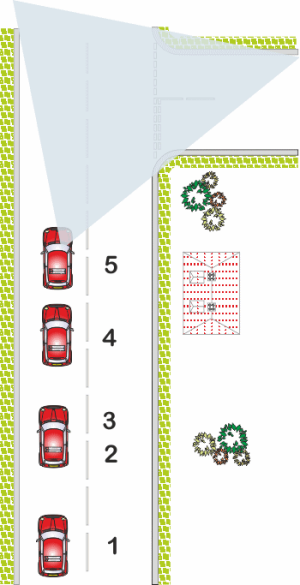
This example deals with the same junction as above, but the driver is going ahead this time. However, the hazard routine is still needed to remain safe if another vehicle moves out or someone crosses the road.
Step 1: Mirrors
When the driver sees the road to the right, they check their mirrors. Remember, just looking is not enough - this driver needs to be aware of the potential actions of following vehicles; an overtaking vehicle could cause real problems.
Step 2 & 3: Signal & Position
Generally speaking, it won't be necessary to give a signal in this situation. However, if a signal is needed, it is likely to be the brake lights - to warn following drivers that you may be slowing down for the junction.
Of course, you might not need to slow down, in which case there is no need for a warning - but it still needs to be considered.
As this driver is not turning, they will keep their normal road position.
Steps 4 and 5:Speed, Gear, Look-Assess-Decide-Act!
The speed will depend on the traffic, the view ahead, pedestrian activity and potentially, lots of other things. Even if the road is clear, it's a good idea to ease slightly off the gas/power to create more time for observation.
The driver scans the shaded area to double-check that no one will pull out or cross the road in front before he drives through - all the time being ready to stop or take other action if the need arises.
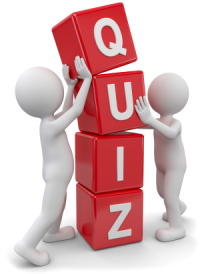
Click here to complete the quiz for this lesson
(The page will open in a new window/tab)
You will find references for the answers in this lesson.
You can check your answers as you go along, or complete the full quiz before checking.
Leaving the check to the end is a good way to test yourself.
When you check or review your answers you will get a brief explanation of the answer.
Good Luck!